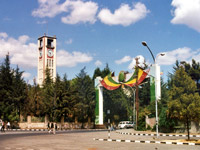 Addis Ababa OverviewAddis Ababa (sometimes spelt Addis Abeba) is a diverse and
riotous capital city of nearly three million souls, with roughly 80
different nationalities, and a multitude of religious and language
groups making up its colourful population. Nestled at the foot of Mount Entoto, the city was founded in the
late 1800s by Ethiopian emperor Menelik II and was later occupied
by the Italians during the second Italo-Abyssinian War. When
Ethiopians regained control, Emperor Haile Selassie immediately set
about rebuilding the capital and formed the Organisation of African
Unity, replaced by today's African Union, which has its
headquarters in the city. Addis Ababa is also home to the world-renowned early hominid
Lucy - her fossilised skeleton, as well as a replica, are housed in
the Ethiopian National Museum. The city also boasts the largest
open market in Africa (in the Merkato district), several
interesting mosques and cathedrals, as well as the world's largest
prefabricated building, Shengo Hall, and Menelik's old Imperial
Palace, which is the official seat of the Ethiopian government. Addis Ababa is an interesting mix of poverty and wealth,
urbanisation and nature (the city is surrounded by forests and
cultivated land). It is a dynamic capital, but has its fair share
of unemployment, petty crime and destitution. Addis Ababa, however,
is well worth exploring, as there are plenty of 'diamonds in the
rough' to be uncovered. |